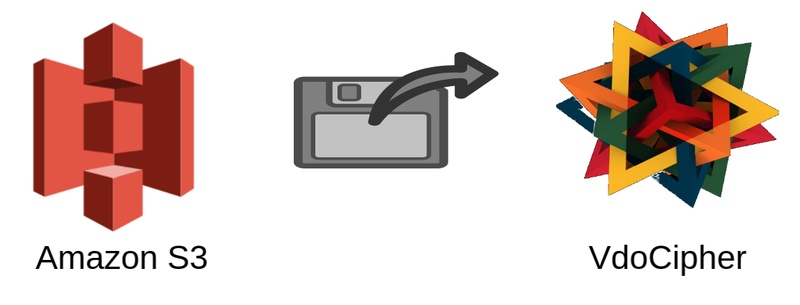Video on Demand platforms have opened up a plethora of choices for viewers. Viewers no longer find themselves dependent upon what their cable network is broadcasting at a particular time. Channel surfing is replaced by informed decision making on VOD platform. Strong recommendation systems help show relevant content to users, thereby optimizing user experience.
Because of this ability to offer a personalized user experience, Video on Demand Platforms retain a phenomenal ability to engage viewers and keep viewers on their platform. Netflix and Amazon Prime Video have both been aggressively building a vast content catalogue. It is imperative for these Over-the-top (OTT) platforms to present just the right kind of content for different kinds of viewer preferences.
Index:
- A Case Study of a Video on Demand Platform – Netflix
- Identify your niche and create your Video on Demand Platform
- Why VdoCipher is best for your Video on Demand Platform
- Select a Tech platform to build your Video on Demand Platform
- Design your website
- Monetization model, Pricing and Payment Processing
A Case Study of a Video on Demand Platform – Netflix
Going back 10 years, Netflix was primarily identified as a DVD-by-mail business. The company had introduced its Video on Demand platform in January 2007 as a bonus for DVD subscribers. What began as a tentative step to build a slight advantage over competitors has now become the world’s biggest Video on Demand platform. In this period the company has consistenly worked to improve its technology stack and content catalogue. The company now has close to a 100 million subscribers, with the number only expected to grow.
Identify your niche and Create your Video on Demand Platforms
As internet connectivity across the world improves, demand for video streaming services will continue to grow. In North America Netflix contributes to over 35% of peak internet traffic. In India broadband connections have become the norm in urban areas, whereas mobile networks led by Reliance Jio are making an aggressive push to enable internet connectivity across the country.
Compared to the costs of creating and distributing videos, revenues are not hard to attain. Setting up a video on demand platform is certainly one of the most attractive proposition for content creators and distributors.
Video on demand means so much more than movies and TV shows. YouTube, which is the world’s biggest VOD platform, enables creators to share videos on niche subjects. Users create videos covering anything from video games, film and music discussion and vlogging to educational videos. To get started you only need to reach out to a small subsection of your potential audience base.
Video content is 40 times more likely to be shared than other forms of content. This means that quality videos can generate an audience with minimal effort in marketing. You need to identify your niche, and offer top-quality content to ensure that your video on demand platform is a success.
Videos are also heavily being used for marketing and for product videos. Four times as many users prefer to to watch a video about a product than read about it.
Video is also revolutionizing E-Learning considerably. Instructors are using video to reach millions of people eager to learn. Massive Open Online Courses (MOOCs) such as EdX, Coursera and MIT OCW have made quality higher learning accessible to anybody with a good internet connection.
You can setup your own video on demand platform, which would give you complete control over your video streaming application.You can directly communicate with your audience, and can interact with them help improve user experience, helping achieve a greater audience.
Setting up your own VOD platform, you can setup your monetization options, opting for either a subscription model or an advertising video on demand business model, as you see fit. You can make further customizations such as custom encoding to optimize bandwidth usage, and custom player skins to offer a customized viewer experience.
It would also mean being no longer dependent on video aggregators like Vimeo and YouTube. YouTube for all its advantages offers limited monetization options. It does not leave the users much control over their content and their audience. Throughout playback viewers are completely free to switch to another video, meaning that meaningful engagement is hard to achieve.
Why VdoCipher is ideal for your VOD Platform
Streaming videos involves a large workflow process, which involves:
- Video Upload and Transcoding
- Upload to secure S3 bucket
- Transcoding to different file formats, enabling multi-bitrate streaming
- Video management through dashboard
- Secure Video Streaming
- Amazon Cloudfront and Akamai CDN network for fast delivery
- Server-side encryption, including HLS encryption
- Player authentication, through backend private key
- Dynamic watermarking
- URL whitelisting
- Smooth video playback
- Design custom skins and customize video player
- Thumbnail customization
- Plugins for WordPress, Joomla!, Drupal, Moodle, and developer-friendly APIs
- Multi-device compatibility
- VAST ad insertion for Advertising Video on Demand platform
- Access video playback analytics through API and dashboard
- Pay per use model – pay for bandwidth and storage
The entire process of conceptualizing, storyboarding, and video production is extremely time and resource-intensive. To regain the investment that goes into making videos you need to ensure effective monetization from content.
Yet piracy presents a major challenge to monetization. Our statistical study shows that about 25% of the world population uses common video download tools to pirate content.
VdoCipher’s large user base relies on our secure video streaming solution to ensure that their monetization opportunities are not affected due to piracy losses. VdoCipher video hosting solution provides the complete solution for video on demand platforms. Our full-stack Video DRM enables video content providers to secure their videos effectively, and set up their videos behind a paywall solution. In this blog we discuss why self-hosting is rarely a good idea. Find more details about how we integrate Widevine DRM for Hollywood-grade security, to provide the best protection for premium content.
Using VdoCipher means that you can continue to focus on improving your website experience and your content catalogue, while resting assured that your viewers are getting a smooth video experience. Buffering is the reason a lot of users leave videos – a study revealed that even for videos of length greater than 30 minutes, a delay of 30 seconds can lead to more than 60% of users leaving the video. Viewers have little patience and high expectations when it comes to streaming videos. VdoCipher has developed expertise in delivering high quality videos in locations with spotty internet connectivity. Video playback through the VdoCipher player is smooth and seamless, and time taken for buffering is minimal.
In this blog we discuss how to use VdoCipher to maximum effect to setup your video on demand platform. To learn more about how the VdoCipher feature set works out for different cases check out this blog on VdoCipher for business.
With VdoCipher, VOD and OTT platforms can now analyze viewer data effectively and apply strong security measures to prevent revenue loss and ensure content integrity.
CMS and Programming Languages to Build your Video on Demand Platform
Create Video on Demand Platform with WordPress
With VdoCipher you can build a video CMS in combination with popular CMS such as WordPress, Drupal, Joomla! and Moodle. WordPress currently powers over 25% of the websites on the internet. Some of the most prominent websites using WordPress because of its easy functionalities are New Yorker magazine and Techcrunch.com

Embed using Shortcodes
- Create an account on VdoCipher. You will be mailed your client secret key.
- Install the VdoCipher wordpress plugin, and enter your client secret key. You are all set to embed VdoCipher videos to your website.
- Right-click on the video in the dashboard that you wish to embed to your website. Copy the video id to the shortcode format, replacing the 123456 in the shortcode below, and using a single parenthesis.
[vdo id="123456"]
- Add the shortcode to the page in which you wish to embed the video. Its a simple two-step process to embedding your video.
Dynamic Watermarking
To add a dynamic watermark go to the settings panel of the VdoCipher plugin, and add the text that you wish to add to your WordPress website. More details are given in this blog.
Themes for WordPress developers
WordPress supports a fantastic community of developers who create plugins and themes. This makes WordPress extremely useful for beginners looking to buy off-the-shelf solutions for their website. To create your own Video on Demand Platform there is a wide variety of themes and plugins that you can use to embed your videos to your websites. Some of the best themes that we have found to offer great functionalities and easy monetization options are:
-
Vlog
Multi-purpose – can be used for vlogging or for news websites.
Supports Series plugin, which enables you to create playlists of videos
Integration with WooCommerce for monetization options
Enables Advertising Video on Demand by supporting banner ads on pages
$69 one-time purchase
-
VideoTube:
$49 cost
Easy integration with membership plugins enabling you to monetize your website as Subscriber Video on Demand
-
VideoPlus
$39 cost – includes 1 year of theme updates and 1 year of personal support
-
PremiumPress Video Theme
$79 cost
Whereas most video themes are designed to enable monetization from advertising video on demand model. PremiumPress’ Video Theme is designed to enable you to secure videos behind a membership plugin.
-
NewsMag Lite
This is free plugin that you can use to create your own newspaper-like or magazine-like website. You can use a combination of texts, images and videos for your site.
Membership Plugins for WordPress
You can manage user access rules using membership plugins. This includes partial protection of content on web pages to restrict content to only paid subscribers. Partial protection is implemented through shortcodes, and means that free subscribers/ non-subscribers can only see part of the page, while the remaining would be protected by a paywall. You can also protect entire sections and pages behind your paywall membership plugins.
WP eMember and Membership Pro 2 are two of the most popular membership plugins. An important feature that WP eMember offers is to prevent simultaneous logins. This stops users from sharing passwords with other people. Another plugin.
Create Video on Demand Platform with Joomla!
Joomla! is one of the most popular PHP-based content management systems. A vibrant community of developers has made Joomla one of the best platforms on which to build your video on demand platform.

VdoCipher’s Joomla video plugin makes all the backend API calls, meaning that all you need to do to embed your videos is add the embed code. The installation procedure to integrate VdoCipher’s video plugin to your Joomla-based video on demand platform is:
- Dowload the VdoCipher Joomla Extension
- Upload the VdoCipher Joomla Extension to the Manage Extensions page
- Click on VdoCipher to open Parameters page
- Enter your client secret key, which you would have received in the mail on registration, in the given field
- On saving the settings you are good to go
- Get your video id directly from the VdoCipher dashboard
- Enter your video id to the shortcode, in the format (where you replace 123456 with your video id)
[vdo id= 123456]
Note that PHP5-curl needs to be installed on the server for this extension to work. Attributes for the shortcode include the display settings of height and width – for example if you require height = 350 and width = 700, you can add the following attributes to the shortcode
[vdo id=123456 height=350 width=700]
The shortcode is space-sensitive, so any additional space at the end of the shortcode before the brackets can cause an error.
Create Video on Demand Platform with Drupal

VdoCipher module for Drupal uses a shortcode to display videos inside any node, which may include articles and posts, besides custom content types. The shortcode is added to the WYSIWYG text editor, and the module handles the API calls. The client secret key is used for API calls between your Drupal website and the VdoCipher video dashboard. The plugin abstracts away the API calls, meaning that all you need to do get started is:
- Upload your video to the VdoCipher dashboard
- Download the VdoCipher module
- Upload the module file from the “Install New Module” page on your Drupal installation
- Click on the Configure link on the module page to complete your setup
- Copy the API Key from VdoCipher Dashboard -> Config -> General
- Enter your client secret API key.
- Get your video id directly from the VdoCipher dashboard
- Enter your video id to the shortcode, in the format
- Embed the video id to any content_type text field in your website
We are currently working on integrating the VdoCipher plugin with the Drupal media module. You can add dynamic watermarks to your video as well using these annotation code guidelines.
Video on Demand Platform with Server-Side scripting languages and Frameworks
We have also developed our API for use-cases with Python, Ruby, Node.js, ASP.NET and PHP. Together these backend-languages power much of the internet. Using our embed code and the API reference for the respective language, you can host your videos to deliver a truly unique experience for your clients.
Web Frameworks that are most popular currently include:
- Django, Flask and Pyramid frameworks for Python
- Rails framework for Ruby
- CakePHP framework for PHP
- Node.js framework for Javascipt
The utility of frameworks is in enabling developers to use boilerplate code, thereby avoiding having to repeat the same thing multiple times. Frameworks help you manage and enforce your web architecture. Using a framework also enables you to use vast a variety of libraries that are available.
For Web Hosting the most popular website hosting servers are DigitalOcean, Rackspace and AWS.
Create Video on Demand Platform with PHP
PHP (PHP: Hypertext Preprocessor) is one of the most popular server-side scripting languages used to build websites. The biggest utility for PHP is its ease-of-use, which has enabled blogging platforms such as WordPress, Joomla! and Drupal to emerge. The world’s largest encyclopedia – Wikipedia is also setup using PHP. Popular e-learning platform Moodle is yet another implementation of PHP. Facebook also uses PHP in its core codebase.
PHP is arguably the easiest language for beginners to make a basic functional website, and for that reason retains its popularity.
In our developer library you can find the embed code for integrating your VdoCipher videos to your website. Using this embed code you would need to add the video id to the embed code, and your client secret key to the API reference, and you would be ready to embed your videos directly to your website.
The developer library also includes sample code for enabling video uploads to your VdoCipher dashboard directly from your website. This would enable your users to directly upload videos without needing to open the dashboard. After the API call is made by your PHP application server, a video upload policy document is returned. You can use standard Javascript libraries to make the process of upload smoother – Angular, JQuery or Dropzone. The video upload should be made within 1 hour of the video upload policy document.
Create Video on Demand Platform with Node.JS
Node.js is currently the most exciting framework for server-side scripting. Its primary utility is its single-thread non-blocking I/O design, which means it is eminently suited for web applications requiring vast scalability. Some of the most popular transaction and event-based web applications currently using Node.js are PayPal, Uber and Netflix
The VdoCipher Node.js module enables you to handle your videos securely on your video hosting platform. VdoCipher’s secure video hosting
Using Node.js for server-side scripting means that both your frontend and backend use Javascript. Most Javascript frameworks are for frontend; Node.js is a singularity in that context. . The Node.js core itself is quite lightweight. There are numerous modules that are made available by an active developer community, adding powerful functionalities to Node.js programming. An active developer community means that for most purposes you could easily find a developer library to achieve a nydesired functionality.
VdoCipher Node.js API
Class VdoCipher. Create a class instance vdocipher (client_secret_key). Instance method of the VdoCipher API include vdocipher.getOTP, which passes the video ID, and receives OTP. Instance method vdocipher.getSignature returns a signature authenticating the video playback.
For more information about the API reference please look up the API reference. Check out the embed code.
You can find sample code to generate OTP for a video on demand platform on WordPress, to authenticate video playback
The github reference can be found here.
Create Video on Demand Platform with Ruby on Rails
Hulu is a major video on demand platform built using Ruby on Rails. Other web applications built using Ruby on Rails framework are SlideShare, Github and Groupon.
Ruby is one of the most popular server-side scripting language. Popular for its developer-friendly structure, Ruby can be used with the Rails framework (Ruby-on-Rails).
VdoCipher gem for Ruby-on-Rails handles the API reference. Steps for integrating VdoCipher video player to your video on demand platform:
- Add this line to your Gemfile in your rails application
gem 'vdocipher'
-
- And in your controller file add these lines
require 'vdocipher'
...
vdo_api = VdoCipher.new(clientSecretKey: "CLIENT_SECRET_KEY");
@embedcode vdo_api.play_code("VIDEO_ID", "style=\"height:400px;width:640px;max-width:100%%;\"");
-
-
- Now in your view file embed code where you would like to play videos
-
Create Video on Demand Platform with Python Frameworks (Django, Flask, Pyramid)
Most popular websites using the Django framework with Python are Instagram, Pinterest, Google. The biggest video on demand platform YouTube, although originally built using PHP, now also runs on Python.
You can see a sample file for integrating VdoCipher to your Python website here. You should break this file, which includes the embed code, player OTP call and API reference, according to your MVC architecture.
Design your Website’s User Interface
A great and intuitive user interface goes a long way towards building and retaining your audience. Here we bring tips from observing popular video on demand platforms, that you should implement to make your VOD platform a success.
-
-
- Clean and Easy Membership system – a popup box can be used to login. You may also enable social login via users Google or Facebook accounts
- These are the home pages of Twitter and Netflix – the similarity? Both of them give a glimpse of interesting content that you find on the platform. This would improve conversion of site visitors to subscribers.


- Personalized Recommendations based on ratings that you give movies and your watch history. Netflix implements a Thumbs Up and Thumbs Down rating system – it aggregates user behaviour across different patterns of ratings. Using your viewership data Netflix recommends content that you are likely to watch.
- Easy grouping of content helps viewers decide what to watch. This includes content based on your recent watch history, and content grouped according to genres such as Action & Adventure and Romantic Films.
- Get your movie descriptions right – help users understand exactly what they are signing up to watch. Your users will appreciate it.
- Multi-Device synchronization – For viewers constrained by time, it may be possible only to consume long-form content in small chunks. By providing synchronization across devices you enable your viewers to start from the last-watched locations, and stop in the knowledge they can resume when they want to on whichever device they wish to. This is one of the most important features to get right. Your video player should be able to synchronize your last played location on the video. VdoCipher gets this right by automatically saving the pointer to the last viewed location on the video, meaning that you can easily play back videos.
- Get the balance between high quality and streaming on low bandwidth networks – It is important to provide a great experience for viewers with high-speed connections as well as for viewers with low-internet bandwidth. This is critical for VOD platforms in developing countries, where internet connectivity in rural areas is poor. Encoding optimizations can help viewers stream reasonably good videos even on 2G-speed internet connections.
-
Monetization Models, Pricing, and Payment Gateway
SVOD – Subscriber Video on Demand
Subscription Video on Demand is definitely the most popular monetization model used by most video on demand platforms. A recurring subscription gives users access to unlimited content on the VOD platform.
To target different kinds of users you can implement a tiered pricing model, wherein subscribers to the basic plan get the core content offering. Subscribers to higher payment plans can get access to additional content that supplements the core video offering. For example Netflix gives unlimited access to its complete library for its basic plan. However if you wish to watch Netflix simultaneously on multiple screens (share a subscription), you are encouraged to buy a multi-screen subscription at a higher price point.

AVOD – Advertiser Video on Demand
As a monetization model, this is the strategy that YouTube offers. Through this YouTube can share revenue with its content creators. In this case, content creators do not have a direct relationship with the video on-demand platform, and therefore advertiser Video on Demand in YouTube’s case enables revenue sharing. AVOD is the optimal strategy when you are expecting a lot of users to tune in to your website.
The only caveat to basing your business model exclusively on advertising is that it is viable only when you have a large audience. Revenue from a single ad is often very low – you need to have a large enough audience to be able to generate meaningful revenue. For videos on subjects of broad interest, the inherent virality of content is extremely critical. In such a case YouTube is often the ideal platform for building and connecting with their audience. If you are looking to build your website with the target of earning revenue from advertising, you should at least target million plus page views per month to build a video platform like youtube.
TVOD – Transactional Video on Demand – Pay per view or buy the content
You can make specific content accessible for users on payment of a fees. This is for one-time content created which you want to monetize. Most online tutorials fall into this category. You can package your videos individually, or as part of a bigger package. The difference between subscription and pay-per-view content is that users pay for access to specific content only. TVOD is ideal when you have differentiated content offerings which have value by themselves.
Payments Gateway and Processing
You need to setup a payment gateway solution so that you can receive payments from across the globe.
Instamojo, PayU and CCAvenue are some of the most popular payment gateways in India. Internationally PayPal and Stripe are both widely trusted payment processors.
Comparison of International Payment Gateways – PayPal and Stripe comparison
| PayPal | Stripe | |
| Ease of use | Easy embed code which can be downloaded from PayPal website | Requires a separate coding framework to integrate Stripe |
| Fixed Monthly Costs | PayPal Standard account is free, Advanced Account costs $5 Pro account costs $30 per month – Advanced and Pro offer native integration with website |
Stripe does not charge any monthly fee |
| Transaction fees | 2.9% + $0.30 per transaction | 2.9% + $0.30 per transaction |
| Customer Support | Better customer support – Quick Answers & Community forum, besides KnowledgeBase and Email support | KnowledgeBase and Email support |
Comparison of Indian Payment Gateways
| Instamojo | Setup Fee – 0 | Commission Per Transaction – 2% + Rs.3 |
| PayU | Setup Fee – Rs. 4,900 – 29,900 | Commission Per Transaction – 0.75% – 2.90% |
| CCAvenue | Setup Fees – Rs. 7,500 – 40,000 | Commission Per Transaction – 3% – 7% |
All Indian payment gateways – Instamojo, PayU and CCAvenue offer integrations with WooCommerce Platform for WordPress. By using any of the free plugins offered by these payment gateways you can get your Video on Demand platform to accept payments within minutes of setting up.
The onboarding process of tying up with the Payment Gateway can take some time though. Most of the payment gateways require scanned copies of documents.
Setting up Payment Gateway for Video on Demand Platform
- Install WooCommerce and the free plugin for the Payment Gateway –
- WooCommerce Settings Page -> Checkout -> Payment Gateways
- Click on the Payment Gateway of your choice after downloading and installing the plugin
- Rename the payment gateway Credit Card/ Debit Card/ Internet Banking
- Configure your payment gateway by adding your merchant ID and Merchant Key
- You can finally select a redirect URL – the page on your website where customers will be taken after the transaction
Individual process for these payment gateways vary. If you opt for any of the payment gateways for your WordPress website it would be a good idea to first integrate it with your WordPress installation to make sure that the plugin is compatible with your WP themes.
If you have more queries on VOD platform, please give us a shout at info@vdocipher.com. A free trial to secure stream videos for your video on demand platform is available at vdocipher.com
Popular FAQs Around VOD Platforms
How can I identify my niche and create a successful Video on Demand platform?
Recognizing your audience and delivering high-quality, targeted content are crucial steps. Video content’s shareability significantly aids audience growth with minimal marketing effort.
Why is VdoCipher considered ideal for VOD platforms?
VdoCipher offers a comprehensive suite of services for secure video streaming, including multi-bitrate streaming, secure S3 bucket upload, transcoding, DRM protection, dynamic watermarking, and detailed analytics.
What are the main monetization models for VOD platforms?
Subscription Video on Demand (SVOD), Advertiser Video on Demand (AVOD), and Transactional Video on Demand (TVOD) are key models, each catering to different content access and payment strategies.
How can I set up payment processing for my VOD service?
Integrating a reliable payment gateway that supports global transactions is essential. Options include PayPal, Stripe, and regional gateways like Instamojo and CCAvenue, depending on your audience’s location.
Supercharge Your Business with Videos
At VdoCipher we maintain the strongest content protection for videos. We also deliver the best viewer experience with brand friendly customisations. We'd love to hear from you, and help boost your video streaming business.




Leave a Reply